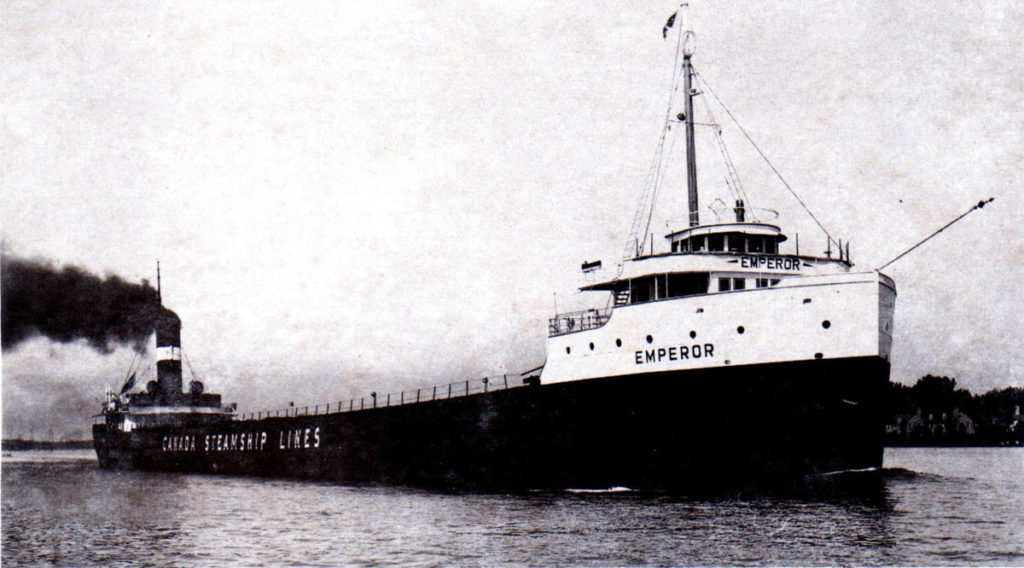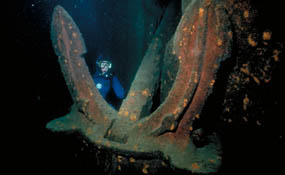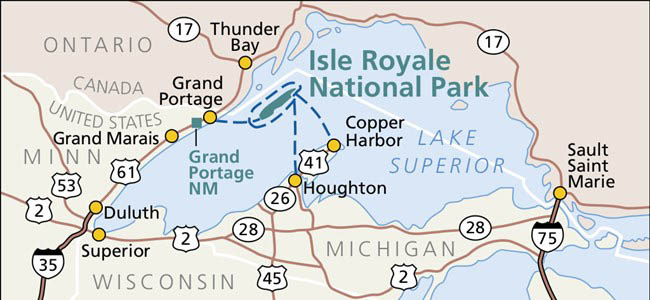The Emperor was built in 1910 by Collingwood Shipbuilding Co., in Collingwood, Ontario, for Inland Lines Ltd. of Midland, Ontario. Launched on December 17, 1910, it was the largest Canadian-made freighter ever constructed at the time of its launch, with a length of 525 feet. It featured a 1,500 horsepower triple expansion steam engine with two Scotch boilers that propelled the ship to a nominal speed of 10 knots. The Emperor was built of steel, with arch and web frame construction to provide an unbroken cargo hold with hatches positioned every 12 feet. The pilot’s cabin, the quarters of the captain and the quarters of the mate were at the ship’s bow, and the quarters and engine room of the crew were aft, with unhindered deck space between them.
Although launched in 1910, the Emperor did not begin its first voyage until April 1911. On its first trip, the ship broke its main shaft in Thunder Bay, Ontario and had to be towed all the way to Detroit, Michigan for repairs. Also in 1911, the ship overrode its anchor while in the Soo locks, tearing a hole in the bottom and sinking the vessel.
Her luck didn’t changed after being sold to Canada Steamship lines in May 1916. It was involved in several other minor accidents, including the death of a member of the crew who fell into the hold in 1918, groundings in 1926 and 1937 and the loss of a rudder in 1936.

The Emperor left Thunder Bay, Ontario on the night of 3 June 1947 on her last fateful trip, laden with 10,429 tonnes of iron ore. Around midnight the captain handed the ship over to the first mate, who had just hours earlier been in charge of loading freight. It is likely that exhaustion led to the inability of the mate to notice Emperor’s incorrect heading as captaining the ship. At 4:15 a.m. on the morning of June 4, the Emperor ran aground on the north side of Canoe Rocks, on the northeast end of Isle Royale. The vessel sank within 30 minutes, killing twelve crew members, including both the captain and the first mate. Nearby was a coast guard cutter, and the remaining crew members were rescued 30 minutes later. Search and rescue operations were conducted soon afterwards, however no survivors were found. Several dives were made to the wreck to find remains of the crew, however no rescue operations were attempted. In 1975, sport divers discovered a body, and it was allegedly removed by Canadian authorities.

The Emperor soon became an attraction for sport divers. Near the site there are some detritus from the 1910 SS Dunelm stranding. The Emperor is largely intact, with damage to the bow, but an intact frame, engine room, and various cabins can be observed. It sits in 25 to 175 feet of water and the the bow sits higher than the stern. The Emperor is the most famous wreck to be dived in the Isle Royale National Park, with more than 350 dives made in 2009 out of 1062 wreck dives in the park.
The Emperor’s wreck at Lake Superior is said to be haunted by a crewman who keeps going about his duties, even in death.
The wreck is listed as “address restricted”, but Isle Royale National Park permits public dives and publishes the location of the wreck. Coordinate location is per “The Wrecks of Isle Royale”.

Getting to Isle Royale is not an easy feat. Isle Royale is surrounded by Lake Superior and provides unprecedented solitude and adventure for backpackers, hikers, boaters, kayakers, canoeists and scuba divers. Isle Royale National Park is located in Lake Superior’s northwest corner. The island has a roadless, backcountry, which prevents all wheeled vehicles and equipment (except wheelchairs) from being used. Visitors travelling to Isle Royale have to arrive by boat or by plane. Transport services are available from Houghton, Michigan, Copper Harbor, Michigan and Grand Portage Minnesota. The island is closed annually from November 1 to April 15.






